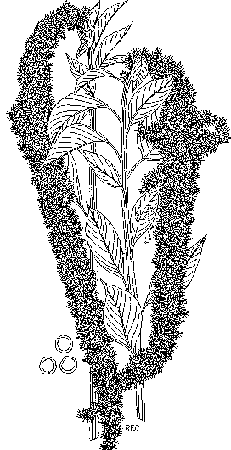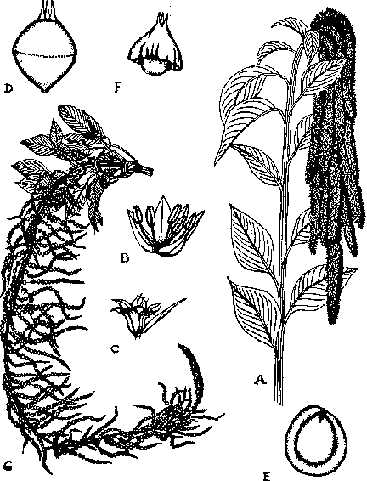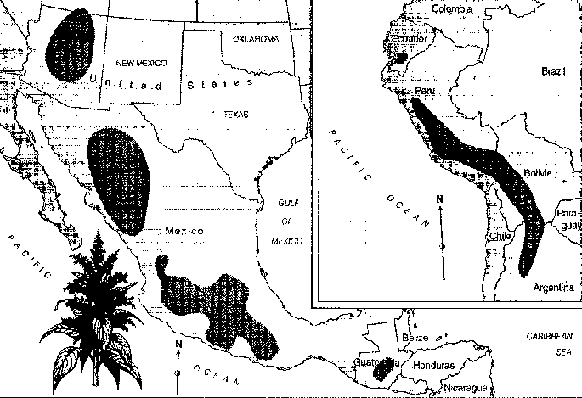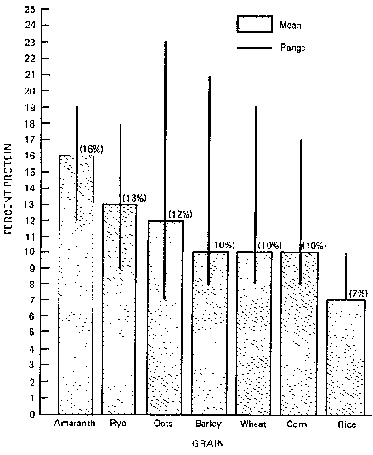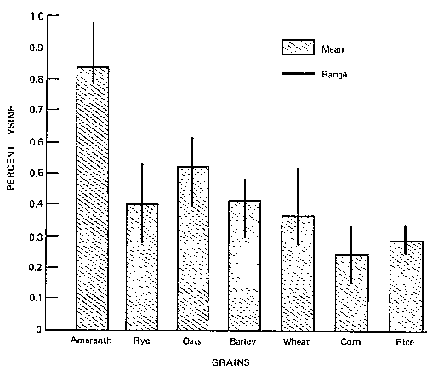Introduction[edit | edit source]
FIGURE
FIGURE
In pre-Columbian times grain amaranth was one of the basic foods of the New World-nearly as important as corn and beans. Thousands of hectares of Aztec, Inca, and other farmland were planted to the tall, leafy, reddish plants. Some 20,000 tons of amaranth grain were sent from 17 provinces to Tenochtitlan (present-day Mexico City) in annual tribute to the Aztec emperor Montezuma.
Amaranth was interwoven with legend and ritual. On various days of the religious calendar,
Aztec women ground the seed, mixed it with honey or with human blood, and shaped it into forms of snakes, birds, mountains, deer, and gods that were eaten either during ceremonies at the great temples or in little family gatherings.
Apparently, this use of amaranth in pagan rituals and human sacrifice shocked the Spanish conquistadors, and with the collapse of Indian cultures following the conquest, amaranth fell into disuse. In the Americas it survived only in small pockets of cultivation in scattered mountain areas of Mexico and the Andes. Corn and beans became two of the leading crops that feed the world, while grain amaranth faded into obscurity and today is largely forgotten.
The Spanish conquest had ended amaranth's use as a staple of the New World and slowed the spread into world agriculture of a highly nutritious food. That amaranth was so important to the Aztec and other New World diets makes it a promising unconventional crop to investigate. Most of the world now receives the bulk of its calories and protein from a mere 20 species-notably cereals such as wheat, rice, maize, millets, and sorghum; root crops such as potato, sweet potato, and cassava; legumes such as beans, peanuts (groundnuts), and soybeans; and sugarcane, sugar beet, and bananas. These plants are the main bulwark between mankind and starvation. It is a dangerously small larder from which to feed a planet.
The Codex Mendoza, commissioned by the Spanish viceroy Antonio de Mendoza in about 1541, reveals that for two-thirds of the towns of the Aztec empire amaranth was a required part of the annual tribute paid to the emperor Montezuma 11. The page shown above lists six towns in the left column and specifies their tribute: four bales of hennequen or cotton mantles in the designs shown; one war dress and shelf with rich feather trim; twenty war dresses with common feather trim; two wooden bins of maize and amaranth; two bins of beans and chia (another little-known Aztec crop), 2,000 salt loaves. Feathery symbols above drawings mean 400. (Drawing courtesy Organization of American States)
The native habitats of grain amaranths (mainly Amaranthus cruentus and Amaranthus hypochondriacus) are distributed throughout Mexico and extend into Guatemala and the southwestern United States. In South America (mainly Amaranthus caudatus) they are found in a band stretching from southern Ecuador through Peru and Bolivia into northern Argentina. (Adapted from information obtained from J. Sauer, courtesy Encyclopaedia Britannica)
To diversify the food base, we should not overlook lesser-known indigenous crops, such as amaranth. Some of them promise to become global resources. A century ago, the soybean, sunflower, and peanut were considered unworthy of concentrated research. Today, they are among the world's most important crops. Amaranth, too, could rise to universal prominence.
Grain Amaranths
Three species of the genus Amaranthus produce large seedheads loaded with edible seeds.
Amaranthus hypochondriacus and Amaranthus cruentus are native to Mexico and Guatemala; Amaranthus caudatus is native to Peru and other Andean countries. All three are still cultivated on a small scale in isolated mountain valleys of Mexico, Central America, and South America, where generations of farmers have continued to cultivate the crops of their forebears.
Amaranths are broad-leafed plants, one of the few nongrasses that produce significant amounts of edible "cereal" grain.
They grow vigorously; resist drought, heat, and pests; and adapt readily to new environments, including some that are inhospitable to conventional cereal crops.
Amaranth is a beautiful crop with brilliantly colored leaves, stems, and flowers of purple, orange, red, and gold.
The seedheads, some as long as 50 cm, resemble those of sorghum. The seeds, although barely bigger than a mustard seed (0.9-1.7 mm in diameter), occur in massive numbers-sometimes more than 50,000 to a plant-and are cream colored, golden, or pink.
With a protein content of about 16 percent, amaranth seed compares well with the conventional varieties of wheat (12-14 percent), rice (7-10 percent), maize (9-10 percent), and other widely consumed cereals. Amaranths began attracting increased research attention in 1972 when Australian plant physiologist John Downton found that the seed also contains protein of unusual quality. It is high in the amino acid Iysine. Cereals are considered "unbalanced" in terms of amino acid composition because generally they lack sufficient amounts of Iysine for optimum health. Amaranth protein, however, has nearly twice the
Iysine content of wheat protein, three times that of maize, and in fact as much as is found in milk-the standard of nutritional excellence. It is, therefore, a nutritional complement to conventional cereals. (Amaranth protein itself is low in leucine, but this amino acid is found in excess in conventional plant protein sources.)
Amaranth seed can be used in breakfast cereals or as an ingredient in confections. It also can be parched or cooked into gruel or milled to produce a sweet, light-colored flour suitable for biscuits, breads, cakes, and other baked goods. Amaranth grain, however, contains little functional gluten, so that it must be blended with wheat flour to make yeast-leavened baked goods "rise."
When heated, the tiny amaranth grains pop and taste like a nuttyflavored popcorn. The popped seeds are light and crisp and are eaten
In northern India amaranth grain is popped and mixed with honey to make a popular confection called laddoos. (M. Pal) as a snack, as a cold cereal with milk and honey, as "breading" on meats or vegetables, or, held together with honey, as a sweet.
Although grain amaranth is a crop of the Americas, some time ago (probably since Columbus) Amaranthus hypochondriacus underwent a remarkable migration to Asia. There, during the last century, it became increasingly popular among hill tribes in India, Pakistan,
Nepal, Tibet, and China. Travellers have reported seeing red and yellow patches of amaranths on the hillsides "tinging with flame the bare mountain slopes." In the Himalayas this amaranth species now is an important crop in a few local areas, and a flat bread made from its seeds is a common food. In fact, it is in this upland Asian region that this American crop now finds its most intensive cultivation. It often occupies more than half of the nonirrigated cropland of the higher elevations in the hills of Northwest India, for example.
Amaranth is gaining popularity also in the northwestern plains of India as well as in the hills of southern India under the common names rajgira ("king seed"), ramdana ("seed sent by God"), and keerai. Indians pop the grain and make it into confections (called laddoos) with honey or syrup, just the way the Aztec and Maya did centuries ago. And among Hindus, popped amaranth grain soaked in milk is now used on certain festival days when eating traditional cereals is forbidden.
One exciting potential of amaranth grain lies in its high protein content as compared with other grains....
. . . Another virtue is the high amount of lysine and methionine, two nutritionally critical amino acids contained in amaranth protein. (Both are charts based on data collected by R.M. Saunders and R. Becker; see Tables I and 2, pages 35 and 36.)
Vegetable Amaranths
Seed is not the only nutritious product from the versatile amaranth. The leaves also are rich in protein as well as in vitamins and minerals. They have a mild flavor, and in much of the world young leaves and stems of amaranth are boiled as greens.
Although virtually unlisted in agricultural statistics, vegetable amaranths may actually be the most popularly grown vegetable crop in the tropics.
In the hot, humid regions of Africa, Southeast Asia (especially Malaysia and Indonesia), southern China, southern India, and the Caribbean, amaranth species such as Amaranthus tricolor, Amaranthus dubius, and Amaranthus cruentus are grown as soup vegetables or for boiled salad greens (potherbs). In North American deserts, where summers are too hot for lettuce or cabbage production, Amaranthus palmer) has long been a major wild green among Indians. In Greece, boiled Amaranthus blitum leaves have been a favorite salad (called vleeta) since the days of Homer.
But, as a recent U.S. Department of Agriculture bulletin pointed out, few species of vegetables are so looked down upon.
The demeaning phrase "not worth an amaranth" exists in several languages. Amaranths are sometimes thought fit only for pigs (hence the common name "pigweed" for one despised American species) and worthy of picking only when one is driven by poverty.
The same bulletin reports that:
Among the vegetables of the tropics, few are as easy to grow as the amaranths. Starting from tiny seed, these species can produce delectable spinachlike greens in 5weeks or less, can continue to produce a crop of edible leaves weekly for up to 6 months, and will then yield thousands of seeds to guarantee their survival. In favorable locations they can reseed themselves automatically and thus continue to produce a useful crop almost without attention. They can also invade plantings of other crops and become serious weeds, competing with slower growing weaker species for light and nourishment. In the tropics, amaranths can produce year round. For little effort, they afford a nutritious dish with abundant provitamin A, a vitamin particularly necessary in the tropics for eye health. Amaranths also produce protein efficiently.
Amaranth Development
Despite the growing evidence in amaranth's favor, much research needs to be done before the crop can be commercially produced. Agronomists are starting almost from scratch in adapting it to modern needs. Nevertheless, the researchers (see Appendix B) are learning the crop's responses to climate, soil conditions, pests, and diseases. Also, they are breeding short-statured plants of uniform height with sturdy, wind-resistant stalks and high-yielding seedheads that hold their seeds until they are harvested.
Leading amaranth's development is the Rodale Research Center near Emmaus, Pennsylvania, where more than a thousand different accessions collected from all parts of the world are being bred, grown' and evaluated. Further collaboration has been initiated with scientists in Africa, Asia, and Latin America; as a result, plant lines have been selected to overcome tendencies toward lodging, seed shattering, indeterminate growth, succulence at harvest time, and daylength dependence. This research effort has produced strains with improved baking, milling, popping, and taste qualities, as well as machinery adapted to planting, cultivating, harvesting, and threshing the crop. Lines of uniform color and height that bear their seedheads above the leaves, thus making them suitable for mechanical harvest, are now available. The crop can be said to be on the threshhold of limited commercial production in the United States, where twenty or so farmers are growing the crop. Several companies are testing the grain in their products, and an amaranth-based breakfast cereal is available.
Evidence indicates that amaranths adapt to many environments and tolerate adversity because they use an especially efficient type of photosynthesis to convert the raw materials of soil, sunlight, and water into plant tissues. Known technically as the C4 carbon-fixation pathway, this process is used by a few other well-known fast-growing crops- sorghum, corn, and sugarcane, for example. The C4 pathway is particularly efficient at high temperature, in bright sunlight, and under dry conditions. Plants that use it tend to require less water than the more common C3 carbon-fixation pathway plants. For this reason, grain amaranth may be a promising crop for hot and dry regions.
Research has mainly emphasized grain amaranths so far, but in 1967 FAO started vegetable amaranth investigations. The following year it began field experiments in home garden projects in Nigeria and Benin. Later it commissioned germplasm collections. As a result, the vegetable branch of the amaranth family is beginning to attract recognition, and FAO has published a report on these species.
YIELD
As yet, amaranth agronomists have paid little attention to improving seed yield. The plants are already quite productive, and researchers are concentrating on characteristics-such as ease of harvest and taste and food-processing qualities-that are more fundamental at this early stage. In Pennsylvania, test plots of productive strains of grain amaranths routinely yield 1,800 kg of seed per hectare. In California and elsewhere, small trial plots have yielded up to nearly twice that amount, and at four locations in the Himachal Pradesh and Uttar Pradesh hills of India, lines selected from the local land races have yielded 3,000 kg of grain per hectare. Therefore, researchers suspect that grain amaranths will eventually match the yields of most other cereals.
As with any new crop, there are many production uncertainties. Problems reported at the various research locations include the lygus bug (an insect that sucks nutrients out of the immature seeds), fast-growing weeds that in some environments overwhelm the slow- starting amaranth seedling, and strains of amaranth that produce seedheads so heavy that they flop over during a summer thunderstorm. These, however, are not insurmountable difficulties.
FUTURE PROSPECTS
Together, the grain- and vegetable-type amaranths could provide many nutritious foods for the world. The small seed size is a limitation in planting as well as in harvesting, threshing, and cleaning the grain. But modern experience in the northern Indian plains shows that they have a good chance of adapting successfully and of being quickly accepted by villagers in
Third World areas where they are adapted.
In the farming of the future, amaranths could find several valuable niches. They might complement other cereals such as sorghum, millets, or barley, thus helping countries that import large amounts of wheat by providing a locally grown extender. In addition, they would provide a local source of feed grain for the burgeoning poultry industries of developing nations. And, in particular, grain amaranth is a promising new crop for dry lands (areas with
600-800 mm of rainfall per year)' for tropical highlands up to extreme elevations (3,500 m and above), and as a quick-maturing, dry-season crop for monsoon areas.
It would be a mistake, however, to expect amaranth to be on dinner plates next year; it took a century for the American public and the farmers to accept the soybean, and it took two centuries for Europeans to accept the potato. Compared with such now-established crops, amaranth has been the object of little modern research or testing. Nevertheless, with today's communications and technology, it should not take that long for amaranth to find its niche.
Within a few years, it seems likely that this ancient grain of the Americas will return to grace the modern age. Eventually, it may prove to be as rich a legacy of the American Indian as maize and beans.

